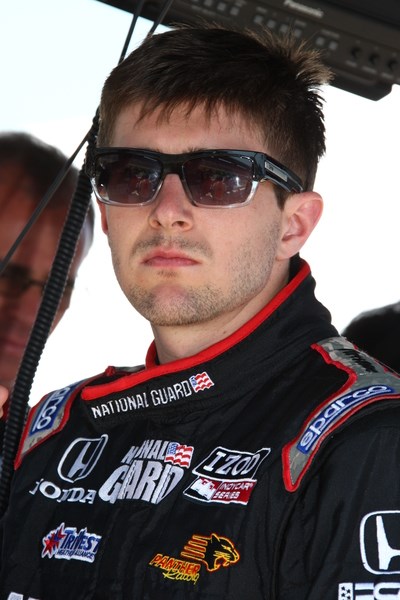
A Rookie Stands Tall After Memorable Crash
June 24, 2011 | By Jeff Olson
Mention of it makes JR Hildebrand grin knowingly, with just a trace of confusion. The reaction to his reaction to the final turn of the Indianapolis 500 was almost as profound as the reaction to what actually happened on the racetrack. He’s aware of it, and only moderately confused by it.
Crash if you will, fans and media seemed to have said, but at least give us some reaction. Throw your helmet. Cry. Scream at people. Apologize profusely to you team. Act like it was horrible, at least.
Instead, Hildebrand, in a stoic show of professionalism uncharacteristic of a 23-year-old rookie, faced everyone and explained himself. Straight up. No blaming, whining or excuses. Just told what happened and the decision he faced and why it didn’t work.
This wasn’t some inexperienced first-timer who blew his grand opportunity. (Had you checked with most major media outlets in the hours and days after the race, you may have sniffed that portrayal in the air.) No, this was an extremely difficult pass that missed by inches after a split-second decision. When it was over and Hildebrand had finished second behind Dan Wheldon, the rookie explained every detail of it. Calmly, rationally and professionally.
By doing so, he won over some folks, but he also turned curious about that particular aspect of the reaction. What were people expecting? Did they want him to jump from the car and start kicking its sidepods? Did they expect a voice-crackling post-race interview? Did they expect him to stand on the track and throw his helmet at the perceived cause of the crash? Did they want anger or sadness?
He handles it like a pro and we’re impressed? As if he would have done anything else?
“Looking back, maybe people were thinking, ‘He’s a rookie. He didn’t know what he was doing,’” Hildebrand said as he prepared for this weekend’s Iowa Corn Indy 250 at Iowa Speedway. “If you watch what happened closely, you’ll know that it’s a more complex situation than just screwing up while making a pass. I think people expected me to be bewildered or have no idea what just happened after the crash, but I knew exactly what I’d done and why I tried to do it. There’s a process, even if it’s split-second, to making that decision. Maybe people were expecting that I wasn’t thinking it through, but I had. It was a risk I had to take.”
This part we do know, and we know it because he carefully explained it to us: Hildebrand didn’t blow the Indy 500. He had a choice to make, and had to make it quickly, and he knew it was a risk before he attempted it. He was approaching Charlie Kimball’s car, which was slowing dramatically, as the two cars entered the fourth turn. Kimball was as low as possible, did everything right. Hildebrand had two choices. Slow and tuck in behind Kimball through Turn 4, or swing around the outside on a track littered with marbles and attempt to maintain the momentum.
The choice had to be made in less time than it took to read the previous sentence. He chose to maintain momentum. He chose the greater of two risks, but it was all done rationally. It was thought out. He didn’t just – doh! – slam it into the wall because he was a rookie or scared or under pressure or foolish. He got into the gray while trying to make a calculated but risky pass at a crucial moment in the race. Sit there behind Kimball, and Wheldon is bound to pull a Sam Hornish Jr. on you at the finish line. The only viable option was to maintain momentum.
But then, a day after the race, people started buzzing about more than the crash. They started buzzing about the way Hildebrand handled himself. Did you see the way the kid dealt with it? Totally calm, without emotion. He just told us what happened, that’s all. Wow.
Apparently we’ve become conditioned to seeing sports stars come unglued over every missed free throw and strikeout. Apparently we expect freak-outs when things go awry. Along comes a kid who’s completely in control except for that split-second when he lost control, and we oooh and ahhhh over his professionalism in the wake of catastrophe. Something is oddly out of sequence about that.
Yes, JR Hildebrand’s response to the Indy 500 was refreshing. But it’s something we should come to expect. Not just from him, but from all of our sports heroes.